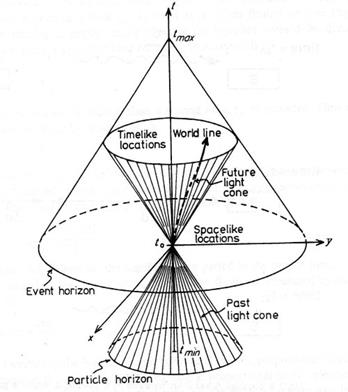Look-back Time. The Finite Speed of Light Causes the Phenomenon of Look-back Time
At first, the very idea of cosmology, i.e. observing the Universe as it exists now so that we can tell how it all began, seems preposterous. It would be like taking a snapshot of a person and telling his or her entire life story from that one single photograph. Yet the aim of this chapter is to explain why cosmologists feel justified in doing this. A key element, which needs introducing right at the beginning of our consideration, is that light and all other forms of electromagnetic radiation can only travel at a finite speed.
As discussed in chapter 2, the speed of light in a vacuum is unsurpassable, with a value of 3 x 108m/s. On terrestrial scales, this means events are communicated almost instantaneously. Over something as large as the Universe, however, events can take a long time to propagate. So long in fact, that the more distant the object, the more in the past we are viewing it.
To quantify this characteristic of the Universe, astronomers have developed a distance measurement system known as the light year. This is the distance travelled by light in a single year and is equivalent to 9.4607 x 1012 kilometres. If two stars are separated by a distance of one light year then events which take place on one stellar surface are only apparent to the other after a period of one year, during which time the light released by the event has travelled the 9.4607 x 1012 kilometres between the two objects.
Closer objects will be able to observe the event before more distant objects. Thus, a galaxy which is one billion light years away will appear to us as it did one billion years ago. This phenomenon is known as look-back time (see Fig. 3. 2).

Fig. 3. 2. The finite speed of light causes the phenomenon of look-back time. The deeper astronomers look into space, the more ancient the objects they see
The information that an event has taken place propagates outwards in a spherical volume around the event with a radius which increases with the speed of light. The ‘surface’ of the sphere is known as the particle’s horizon. Over small volumes of space, an event which took place at time, t1, will have a present day (i.e. time = t0) particle horizon, re, of:

Over large distances of space, relativistic effects will destroy the simplicity of this relationship. Diagrammatically, this behaviour is represented by a light cone (see Fig. 3. 3).

Fig. 3. 3. Light cones show the propagation of light from an event. If one event is situated within the light cone of the other, then they are causally connected. If one event is situated outside the light cone of the other, then the two events are not yet aware of each other’s existence. (Adapted from Roos, M., Introduction to Cosmology, Wiley, 1994.)
Light cones are drawn on Minkowski spacetime diagrams, named after the physicist who first proposed the concept of spacetime. Anything which exists in the Universe can be plotted on a spacetime diagram. They will follow paths known as ‘world lines’. For unaccelerated travel, world lines are straight but acceleration causes them to become curves.
The gradient of a world line is an indication of how fast the object is travelling. For example, a stationary object will have a world line gradient of either zero or infinity depending upon the orientation of the time axis. Light rays, being the fastest thing in the Universe, follow paths called ‘geodesics’ through the spacetime continuum and have a set gradient for their world lines.
Objects within each other’s light cones are causally connected, i.e. they have been able to exchange photons and hence can cause effects to occur during their respective lifetimes. The two objects are then said to have a time-like separation. Objects not within one another’s light cones are said to possess space-like separation.
If one considers the light cone of the observable Universe, then it becomes obvious that there could very well be objects which we do not know exist because light from them has not reached us yet. Since the light cone of the Universe is defined by its age, any object which has a space-like separation from us cannot possibly have influenced our evolution.
These unknowable regions are termed domains and could, conceivably, have totally different laws of physics. The limit of our observable Universe is known as an event horizon. Unfortunately, we cannot observe it because the cosmic microwave background blinds our sight, as we shall soon discover.
Date added: 2023-09-14; views: 683;
